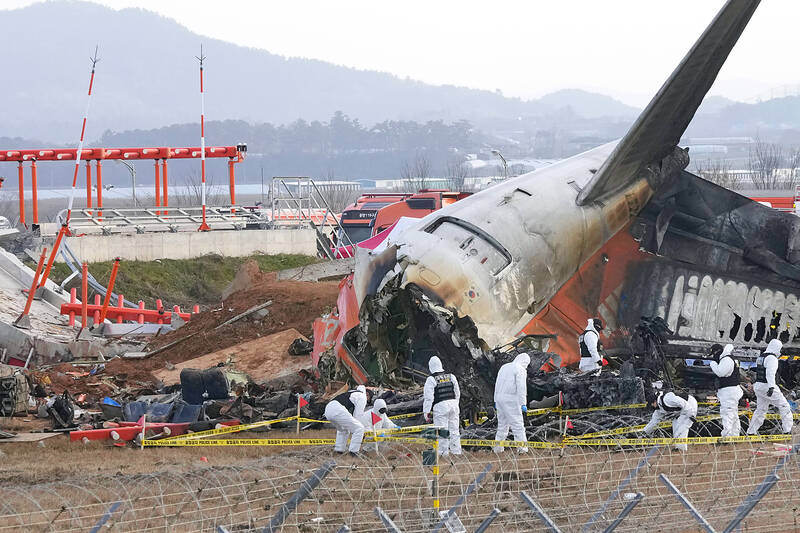A team of US investigators, including representatives from Boeing, on Tuesday examined the site of a plane crash that killed 179 people in South Korea, while authorities were conducting safety inspections on all Boeing 737-800 aircraft operated by the country’s airlines.
All but two of the 181 people aboard the Boeing 737-800 operated by South Korean budget airline Jeju Air died in Sunday’s crash. Video showed the aircraft, without its landing gear deployed, crash-landed on its belly and overshoot a runaway at Muan International Airport before it slammed into a barrier and burst into flames.
The plane was seen having engine trouble. Preliminary examinations also say that the pilots received a bird strike warning from the ground control center and issued a distress signal as well.

Photo: AP
However, experts say the landing gear issue was likely the main cause of the crash.
The South Korean government has launched safety inspections on all the 101 Boeing 737-800s in the country.
The South Korean Ministry of Land, Infrastructure and Transport said that authorities were looking at maintenance and operation records during five days of safety checks that are to run until tomorrow.
The ministry said that a delegation of eight US investigators — one from the US Federal Aviation Administration, three from the US National Transportation Safety Board and four from Boeing — made an on-site visit to the crash site on Tuesday.
The results of their examination were not immediately available.
Jeju Air president Kim E-bae on Tuesday told reporters that his company would add more maintenance workers and reduce flight operations by 10 to 15 percent until March as part of efforts to enhance the safety of aircraft operations.
John Hansman, an aviation expert at the Massachusetts Institute of Technology, said that the crash was most likely the result of a problem with the plane’s hydraulic control systems.
That would be consistent with the landing gear and wing flaps not being deployed, “and might indicate a control issue which would explain the rush to get on the ground,” Hansman said.
The Boeing 737-800 — an earlier version of 737 than the MAX — is a widely used plane with a good safety record, said Najmedin Meshkati, an engineering professor at the University of Southern California who has studied aviation safety.
The failure of the plane’s system for broadcasting location, operating its landing gear and extending the wing flaps to slow down indicate a widespread problem that affected electrical and hydraulic systems, Meshkati said.
Investigators would learn what went wrong by analyzing information from the flight data and cockpit voice recorders, he said.
“These are really the two pillars for accident analysis and accident reconstruction,” Meshkati said.
Like other aviation experts, Meshkati also questioned the location of a solid wall just a few hundred meters past the end of the runway, given that planes occasionally do overshoot runways.
“Having such a big concrete barrier over there was really very bad luck for this particular airplane,” he said.
South Korean officials have said they will look into whether the Muan airport’s localizer — a concrete fence housing a set of antennas designed to guide aircraft safely during landings — should have been made with lighter materials that would break more easily upon impact.

FRAUD ALLEGED: The leader of an opposition alliance made allegations of electoral irregularities and called for a protest in Tirana as European leaders are to meet Albanian Prime Minister Edi Rama’s Socialist Party scored a large victory in parliamentary elections, securing him his fourth term, official results showed late on Tuesday. The Socialist Party won 52.1 percent of the vote on Sunday compared with 34.2 percent for an alliance of opposition parties led by his main rival Sali Berisha, according to results released by the Albanian Central Election Commission. Diaspora votes have yet to be counted, but according to initial results, Rama was also leading there. According to projections, the Socialist Party could have more lawmakers than in 2021 elections. At the time, it won 74 seats in the

A Croatian town has come up with a novel solution to solve the issue of working parents when there are no public childcare spaces available: pay grandparents to do it. Samobor, near the capital, Zagreb, has become the first in the country to run a “Grandmother-Grandfather Service,” which pays 360 euros (US$400) a month per child. The scheme allows grandparents to top up their pension, but the authorities also hope it will boost family ties and tackle social isolation as the population ages. “The benefits are multiple,” Samobor Mayor Petra Skrobot told reporters. “Pensions are rather low and for parents it is sometimes

CANCER: Jose Mujica earned the moniker ‘world’s poorest president’ for giving away much of his salary and living a simple life on his farm, with his wife and dog Tributes poured in on Tuesday from across Latin America following the death of former Uruguayan president Jose “Pepe” Mujica, an ex-guerrilla fighter revered by the left for his humility and progressive politics. He was 89. Mujica, who spent a dozen years behind bars for revolutionary activity, lost his battle against cancer after announcing in January that the disease had spread and he would stop treatment. “With deep sorrow, we announce the passing of our comrade Pepe Mujica. President, activist, guide and leader. We will miss you greatly, old friend,” Uruguayan President Yamandu Orsi wrote on X. “Pepe, eternal,” a cyclist shouted out minutes later,

CONTROVERSY: During the performance of Israel’s entrant Yuval Raphael’s song ‘New Day Will Rise,’ loud whistles were heard and two people tried to get on stage Austria’s JJ yesterday won the Eurovision Song Contest, with his operatic song Wasted Love triumphing at the world’s biggest live music television event. After votes from national juries around Europe and viewers from across the continent and beyond, JJ gave Austria its first victory since bearded drag performer Conchita Wurst’s 2014 triumph. After the nail-biting drama as the votes were revealed running into yesterday morning, Austria finished with 436 points, ahead of Israel — whose participation drew protests — on 357 and Estonia on 356. “Thank you to you, Europe, for making my dreams come true,” 24-year-old countertenor JJ, whose